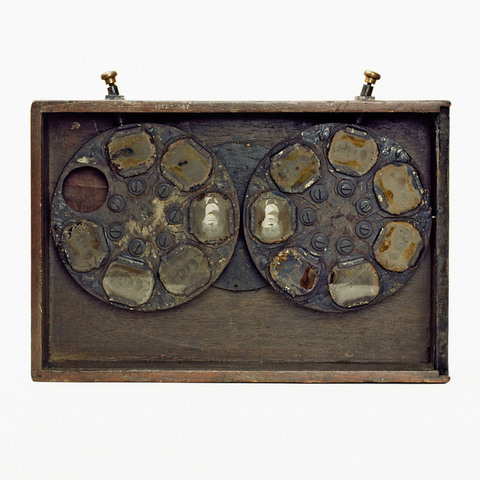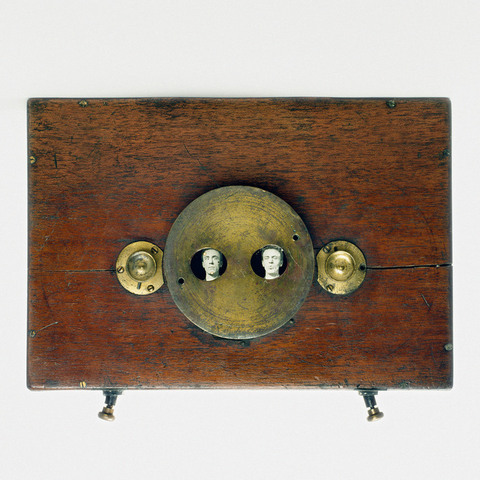Lanterne de projection (accessoire de)
Fiche détaillée
Type de l'appareil
deux disques en acier percés de sept trous chacun ; six vues photographiques positives ovales sur le premier disque (une vue absente) ; sept vues photographiques positives ovales sur le deuxième disque ; deux poussoirs en cuivre pour bloquer les deux disques ; deux boutons de cuivre pour avancer et reculer les vues ; encadrement de bois ; tube en cuivre pour concentrer la lumière sur les vues
Auteurs
Rudge John Arthur Roebuck
Bath
Friese-Greene William
Bath
Fabricants
John Arthur Roebuck Rudge
Bath
Utilisateurs
Rudge John Arthur Roebuck
Bath
Friese-Greene William
Bath
Distributeurs
Informations non disponibles
Sujet du modèle
Visage d'un homme qui fait des grimaces
Objectif
Informations non disponibles
Taille de l'objet
Ouvert :
Informations non disponibles
Fermé :
Longueur : 35.5 cm
Largeur : 10.5 cm
Hauteur : 26.5 cm
Diamètre :
Informations non disponibles
Taille de la boîte de transport
Informations non disponibles
Remarques
"101. One Bio-Phantoscope, by John Arthur Roebuck Rudge, a native of Bath, England, who was experimenting with portraying movement upon the lantern screen by photographic means as far back as 1868, and this instrument represents one of his first efforts, and carries two discs of facial photographs of Rudge's nephew when a boy. There is an ingenious locking device to each figure disc to lock each picture as shown in turn, alternating from one disc to the other, and sliding the Bio-Phantoscope into position to expose each photograph in turn in rapid sequence. This instrument is unique, as it shows one of the earliest known forms for showing movement upon the lantern screen by photographic means ; date about 1868" (Will Day, Illustrated Catalogue of the Will Day Historical Collection, Londres, s.d., [1930], p. 17).
"Raymond Newport believes that Rudge used the name "Biphantoscope" indiscriminately for any of his devices, but there is no evidence that it was ever applied to "Life in the Lantern" or "Jumbo'us Funniosities". Moreover Friese-Greene, apparently introducing the four-image device as Rudge's invention, always referred to it as the "Phantoscope". In the case of Rudge's final device, the name appears in some references as "Biphantoscope" and this would seem the most likely form. Rudge appears from all accounts to have been a throughtful, even pedantic man, and it would be natural to distinguish between the "Biophantic" lantern ("Bio" signifying "life") and the "Biphantoscope" ("Bi" signifying "double"). In this device, a series of images showing the changing expressions of a face are arranged in circular apertures around the perimeters of two revolving metal discs housed in a lantern-slide frame. By means of piston actions, the individual images are brought successively into position before two circular apertures in the slide. A special projection lantern woulf have been required, with a double lens to register the images from the two discs on the same point of the screen. The lantern would have required an arrangement to alternate the light source between the two apertures. An exemple of the Biphantoscope was given to the Science Museum, London, by Edgar Rudge, but was absorbed into the Will Day Collection (...). The dating again gives certain problems. Since it was clearly a development from the four-image phantoscope, this device cannot have been earlier than 1887" (David Robinson, "The Motion Picture Experiments of John Arthur Roebuck Rudge", The New Magic Lantern Journal, volume 8, n° 2, octobre 1997, p. 6).
Bibliographie
Will Day, "The Progenitor of the Motion Picture Projector", The Year's Photography, Vol. LXVII, 1927.
Will Day, Illustrated Catalogue of the Will Day Historical Collection, Londres, s.d., [1930], p. 17.
Brian Coe, "W. Friese-Greene and the Origins of Kinematography", The Photographic Journal, Vol. 102, mars 1962.
David Robinson, "The Motion Picture Experiments of John Arthur Roebuck Rudge", The New Magic Lantern Journal, volume 8, n° 2, octobre 1997, p. 1-7.

